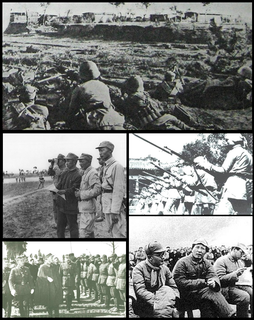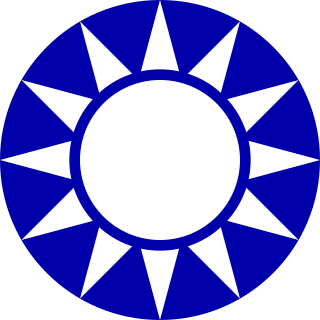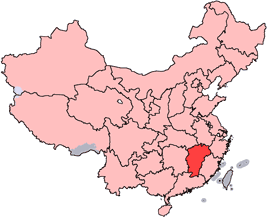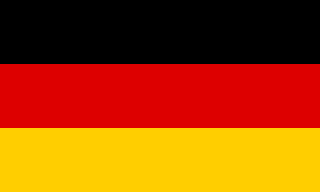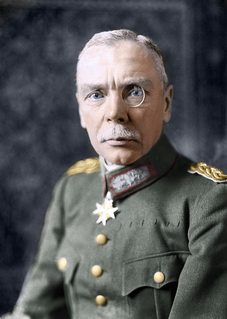Handan Campaign (邯郸战役), also known as Pinghan Campaign (平汉战役), short for Beiping-Hankou Campaign (北平汉口战役), is one of the largest clashes between the communist force and the nationalist force immediately after the end of World War II, which resulted in communist victory.
The Huaiyin-Huai'an Campaign (两淮战役) was a campaign consisted of several battles fought between the nationalists and the communists during the Chinese Civil War in the immediate post-World War II era, and resulted in communists taking the city of Huaiyin and the city of Huai'an. Sometimes this campaign is separated into two by the communists as Huaiyin Campaign (淮阴战役) and Huai'an Campaign (淮安战役) respectively.
The battle of Wuhe (五河战斗) was a battle fought at the Five Rivers region in eastern Anhui was a clash between the communists and the former nationalists turned Japanese puppet regime force who rejoined the nationalists after World War II. The battle was one of the Chinese Civil War in the immediate post World War II era.
The Xinghua Campaign (兴化战役) consisted of two battles fought between the communist New Fourth Army and the nationalist forces of the Kuomintang. The campaign took place during the Chinese Civil War in the immediate post-World War II era, and resulted in a communist victory.
The Battle of Houmajia was a battle fought between the nationalists and the communists in the Houmajia region of Lingbi (灵壁) County of Anhui, China during the Chinese Civil War in the immediate post-World War II era, and resulted in a communist victory.
The Battle of Xiangshuikou (响水口战斗) was a battle fought between the nationalists and the communists in northern Jiangsu during the Chinese Civil War in the immediate post-World War II era, and resulted in a communist victory.
The Battle of Tangtou–Guocun (塘头郭村战斗) was a series of clashes between the nationalists and the communists during the Chinese Civil War in the immediate post-World War II era in Jiangsu, China and resulted in the communist victory.
The Battle of Dazhongji (大中集战斗) was fought between the nationalists and the communists during the Chinese Civil War in the immediate post-World War II era in Jiangsu, China and resulted in the communist victory.
The Battle of Tianmen (天门战斗) was a battle between the nationalists and the communists immediately after World War II during the Chinese Civil War in Tianmen, Hubei, China and resulted in communist victory.
The Battle of Rugao (如皋战斗) was a battle fought between the nationalists and communists for the control of town of Rugao in Jiangsu province during the Chinese Civil War in the immediate post-World War II era, and resulted in the communist victory.
The battle of Shaobo (邵伯战斗) was a battle fought in the Shaobo (邵伯) region in central Jiangsu, and it was a clash between the communists and the former nationalists turned Japanese puppet regime force who rejoined the nationalists after World War II, and it is a prelude to Gaoyou Campaign. The battle resulted in communist victory was one of the Chinese Civil War in the immediate post World War II era.
The Battle of Yongjiazhen (雍家镇战斗) was fought during the aftermath of World War II in the Yongjiazhen (雍家镇) region of central Anhui, China between Communist forces and Kuomintang forces who had allied with the Japanese. The battle was part of the Chinese Civil War, resulting in a victory for the People's Liberation Army.
The Battle of Shicun (时村战斗) was a battle fought at the Time Village of Xiu (宿) County in Anhui, and it was a clash between the communists and the former nationalists turned Japanese puppet regime force who rejoined the nationalists after World War II. The battle was one of the Chinese Civil War in the immediate post World War II era.
The Battle of Lingbi (灵璧战斗) was a battle fought at the Lingbi (灵璧) region in Anhui, and it was a clash between the communists and the former nationalists turned Japanese puppet regime force who rejoined the nationalists after World War II. The battle was one of the Chinese Civil War in the immediate post World War II era, and resulted in communist victory.
The battle of Yinji (尹集战斗) was a battle fought at the Yin Village of Wuyang (舞阳) County in southern Henan, and it was a clash between the communists and the former nationalists turned Japanese puppet regime force who rejoined the nationalists after World War II. The battle was one of the Chinese Civil War in the immediate post World War II era, and resulted in communist victory.
Southern Jiangsu Campaign was a 1945 series battle fought at the Southern Jiangsu and adjacent regions in Anhui and northern Zhejiang, and it was a clash between the communists and the former nationalists turned Japanese puppet regime force who rejoined the nationalists after World War II with their Japanese ally. The battle was one of the Chinese Civil War in the immediate post World War II era, and resulted in communist victory.

The Second Encirclement Campaign against the Shaanxi-Gansu Soviet was an encirclement campaign launched by the Chinese Nationalist Government that was intended to destroy the communist Shaanxi-Gansu Soviet and its Chinese Red Army in the local region. It was responded by the Communists' Second Counter-Encirclement Campaign at Shaanxi-Gansu Soviet, also called by the communists as the Second Counter-Encirclement Campaign at Shaanxi-Gansu Revolutionary Base, in which the local Chinese Red Army successfully defended their soviet republic in the border region of Shaanxi and Gansu provinces against the Nationalist attacks from April 1935 to July, 1935.
The Linyi Campaign (临沂战役) was a campaign fought in Shandong, and it was a clash between the communists and the former nationalists turned Japanese puppet regime force who rejoined the nationalists after World War II. The battle was part of the Chinese Civil War in the immediate post World War II era, and resulted in communist victory.
The Houma Campaign (侯马战役), also dubbed as Houma Counteroffensive (侯马反击战), was a series of battles fought between the nationalists and the communists during Chinese Civil War in the post World War II era, and resulted in the communist victory.
The Pingdu Campaign (平度战役) was a 1945 campaign fought between the communists and the former nationalists turned Japanese puppet regime force who rejoined the nationalists after World War II. The battle was one of the Chinese Civil War in the immediate post World War II era, and resulted in victory for the Communist Party of China.

